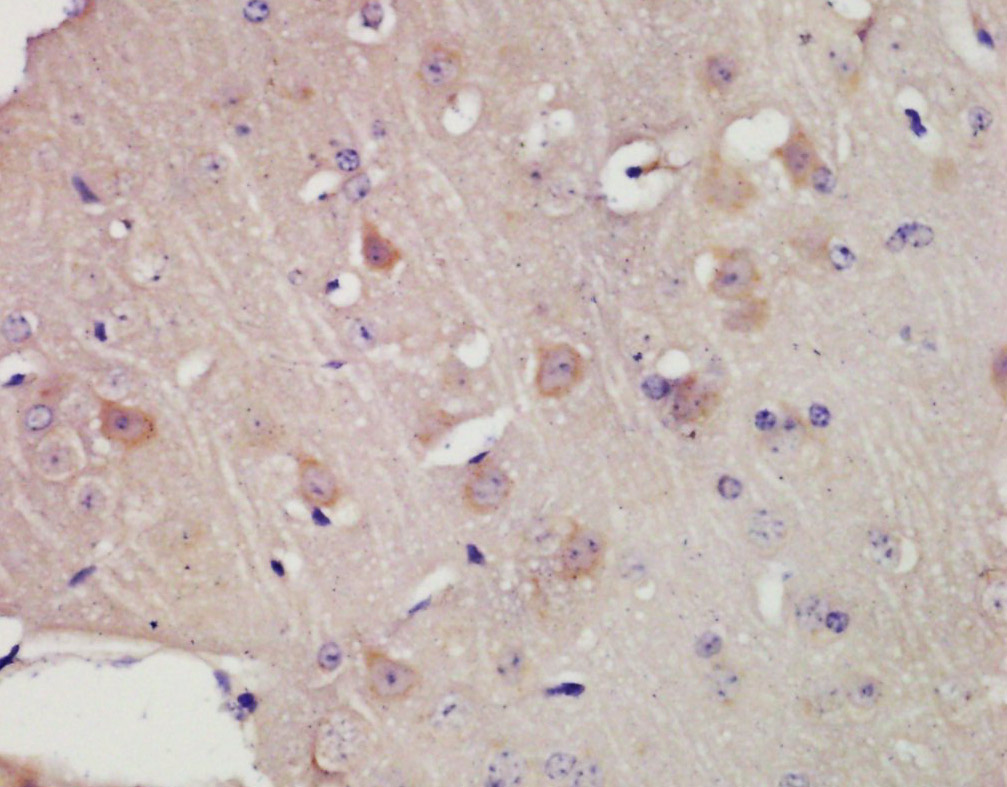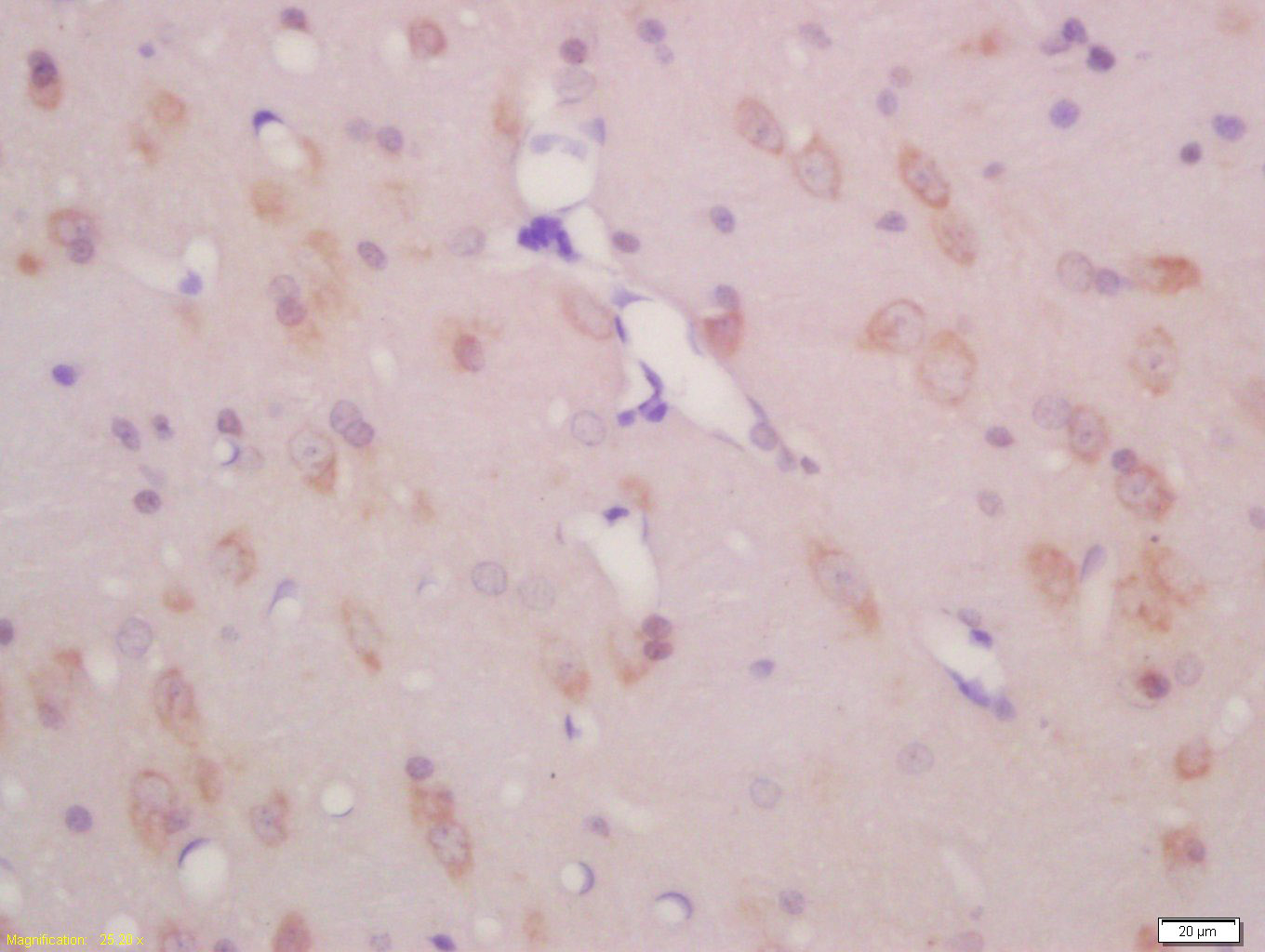
Rabbit Anti-KCNC3 antibody
Kv3.3; potassium voltage gated channel, Shaw-related subfamily, member 3; KSHIIID; KV3.3; Potassium voltage gated channel subfamily C member 3; SCA13; Shaw related subfamily, member 3; Shaw related voltage gated potassium channel protein 3; Spinocerebella
View History [Clear]
Details
Product Name KCNC3 Chinese Name 离子Channel proteinKv3.3抗体 Alias Kv3.3; potassium voltage gated channel, Shaw-related subfamily, member 3; KSHIIID; KV3.3; Potassium voltage gated channel subfamily C member 3; SCA13; Shaw related subfamily, member 3; Shaw related voltage gated potassium channel protein 3; Spinocerebellar ataxia 13; Voltage gated potassium channel protein KV3.3; Voltage gated potassium channel subunit Kv3.3. Research Area immunology Neurobiology Channel protein The cell membrane受体 Immunogen Species Rabbit Clonality Polyclonal React Species Mouse, Rat, (predicted: Human, Chicken, Dog, Cow, Horse, Rabbit, ) Applications ELISA=1:5000-10000 IHC-P=1:100-500 IHC-F=1:100-500 IF=1:100-500 (Paraffin sections need antigen repair)
not yet tested in other applications.
optimal dilutions/concentrations should be determined by the end user.Theoretical molecular weight 81kDa Cellular localization cytoplasmic The cell membrane Form Liquid Concentration 1mg/ml immunogen KLH conjugated synthetic peptide derived from human Kv33: 501-600/757 Lsotype IgG Purification affinity purified by Protein A Buffer Solution 0.01M TBS(pH7.4) with 1% BSA, 0.03% Proclin300 and 50% Glycerol. Storage Shipped at 4℃. Store at -20 °C for one year. Avoid repeated freeze/thaw cycles. Attention This product as supplied is intended for research use only, not for use in human, therapeutic or diagnostic applications. PubMed PubMed Product Detail The Shaker gene family of Drosophila encodes components of voltage-gated potassium channels and is comprised of four subfamilies. Based on sequence similarity, this gene is similar to one of these subfamilies, namely the Shaw subfamily. The protein encoded by this gene belongs to the delayed rectifier class of channel proteins and is an integral membrane protein that mediates the voltage-dependent potassium ion permeability of excitable membranes. [provided by RefSeq].
Function:
This protein mediates the voltage-dependent potassium ion permeability of excitable membranes. Assuming opened or closed conformations in response to the voltage difference across the membrane, the protein forms a potassium-selective channel through which potassium ions may pass in accordance with their electrochemical gradient.
Subunit:
Heterotetramer of potassium channel proteins.
Subcellular Location:
Membrane; Multi-pass membrane protein.
DISEASE:
Spinocerebellar ataxia 13 (SCA13) [MIM:605259]: Spinocerebellar ataxia is a clinically and genetically heterogeneous group of cerebellar disorders. Patients show progressive incoordination of gait and often poor coordination of hands, speech and eye movements, due to degeneration of the cerebellum with variable involvement of the brainstem and spinal cord. SCA13 is an autosomal dominant cerebellar ataxia (ADCA) characterized by slow progression and variable age at onset, ranging from childhood to late adulthood. Mental retardation can be present in some patients. Note=The disease is caused by mutations affecting the gene represented in this entry.
Similarity:
Belongs to the potassium channel family. C (Shaw) (TC 1.A.1.2) subfamily. Kv3.3/KCNC3 sub-subfamily.
SWISS:
Q14003
Gene ID:
3748
Database links:Entrez Gene: 3748 Human
Entrez Gene: 16504 Mouse
Omim: 176264 Human
SwissProt: Q14003 Human
SwissProt: Q63959 Mouse
Unigene: 467146 Human
Unigene: 40312 Mouse
Unigene: 9885 Rat
Product Picture
Antigen retrieval: citrate buffer ( 0.01M, pH 6.0 ), Boiling bathing for 15min; Block endogenous peroxidase by 3% Hydrogen peroxide for 30min; Blocking buffer (normal goat serum,C-0005) at 37℃ for 20 min;
Incubation: Anti-KCNC3 Polyclonal Antibody, Unconjugated(SL2587R) 1:200, overnight at 4°C, followed by conjugation to the secondary antibody(SP-0023) and DAB(C-0010) staining
Tissue/cell: rat brain tissue; 4% Paraformaldehyde-fixed and paraffin-embedded;
Antigen retrieval: citrate buffer ( 0.01M, pH 6.0 ), Boiling bathing for 15min; Block endogenous peroxidase by 3% Hydrogen peroxide for 30min; Blocking buffer (normal goat serum,C-0005) at 37℃ for 20 min;
Incubation: Anti-KCNC3 Polyclonal Antibody, Unconjugated(SL2587R) 1:200, overnight at 4°C, followed by conjugation to the secondary antibody(SP-0023) and DAB(C-0010) staining
References (0)
No References
Bought notes(bought amounts latest0)
No one bought this product
User Comment(Total0User Comment Num)
- No comment




 +86 571 56623320
+86 571 56623320
 +86 18668110335
+86 18668110335

